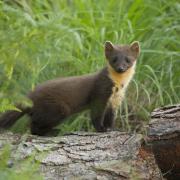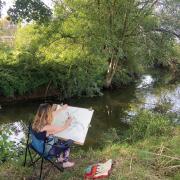Grazing horses can benefit species-rich grasslands – and vice versa, as Siân Ellis hears from the experts.
Wildflower-rich limestone grasslands are one of the beautiful summer sights around the Cotswolds: speckled with orchids, bird’s-foot trefoil, salad burnet and other colourful flora. Take a closer look and you’ll also see a teeming world of invertebrates and pollinators that thrives in such habitat including national rarities like Chalkhill Blue and Duke of Burgundy butterflies. Voles, birds, bats and other mammals in the food chain won’t be far away.
It’s well known that vast swathes of our species-rich grassland have been lost due to factors ranging from changed farming practices to urban development. Coverage in the Cotswolds has shrunk from 40% in the 1930s to a mere 1.5%. Luckily, since 2019, the Glorious Cotswold Grasslands team and partners have been restoring and creating new wildflower meadows, with work initiated on more than 300 hectares from 2019 to 2022, and ambitious plans for much more.
Meadows need to be managed to encourage wildflowers. ‘If you just leave them unchecked, they will eventually be taken over by coarse grasses and scrub,’ says Anna Field, Glorious Cotswold Grasslands Programme Officer. Taking an annual hay-cut and grazing encourage a low-nutrient soil and remove tussocky grass, encouraging less-competitive wildflowers to flourish.
‘When people think of conservation grazing, they usually think of cattle and sheep. But horses can do the job too if managed properly,’ Anna continues. ‘There are a number of examples in the Cotswolds where unimproved grassland is being successfully grazed by ponies and horses, and where there is a huge diversity of wildflowers.’

Beneficial grazing
Horse-owner and conservationist Frances Standen agrees. ‘Horses can be really effective managers of wildflower meadows because they are selective grazers and will often select the grass species, which then allows the flowers to flower and set seed.’
The benefits go both ways, with a species-rich sward providing equine health benefits. ‘Horses have evolved to do well on a very high-fibre, low-sugar diet,’ Frances says. ‘But often they are grazed on grasses that are too high in sugar and very low in fibre, on pastures where rye grass predominates, this can lead to welfare issues like laminitis [a painful, even fatal condition affecting tissues in hooves/feet].
‘Happily, more traditional grassland, which is full of a variety of grasses, flowers and herbs, is much better for horses because it is providing them with a much more fibrous diet. Also, because the different species of flowers, grasses and herbs will root at different depths they are drawing up a wider range of minerals and nutrients. That can be very beneficial to the horse and to the soil structure. So, diversity is good for horses with some plants giving particular benefits; there is anecdotal evidence for example which suggests bird’s-foot trefoil has anthelmintic properties, which help animals to resist worms naturally.’
As ‘trickle feeders’, horses like to browse throughout the day and used to walk miles doing so. Most modern equines are kept differently, and every equine and its needs are different but there are many things that can be considered to provide benefits for the horse and the diversity of the grassland sward.
The key thing is to have pastures of an appropriate size for your horse(s), in order to avoid over-grazing, Frances says. ‘If you’ve got an appropriate stocking density you can rest and rotate your pasture and provide a great deal of the nutritional requirements for the horse from the pasture. Resting a field, or part of a field, from April to the end of July or later, allows flowers to flower and set seed.’

If someone cannot rotate grazing between fields, ‘it can even be beneficial just to leave a strip for wildflowers in your field and perhaps alter where that strip is, maintaining or finding out what you’ve got in the seedbank. Seed for meadow species can stay viable in a seedbank for up to 50 years.
‘I am able to keep land back ungrazed from April until November, and then put horses on so they are grazing standing hay (foggage) over the winter: the thick thatch of grass also withstands the horses’ hooves in the wetter months reducing poaching,’ Frances adds. ‘Then there is no need to pay someone to come and make hay.’
Other tips include: don’t fertilise pasture (also a cost saving) as wildflowers thrive best on nutrient-poor soils. Avoid rolling as that will detrimentally compact soil, only spot spray if necessary. Encourage extensive foraging (if you have large enough fields) that avoids trampling, poaching and the creation of over-used, worn areas.
‘If you are grazing extensively – I am very fortunate and can do that – mixed grazing is another good way of managing pasture,’ Frances says. ‘Sheep will tidy up areas that horses won’t eat, and help to reduce parasite burden.
‘It’s so inspiring when you see a wildflower meadow: they are so beautiful, and to think you can achieve that with your horses as the main grazing animal – it’s a double benefit.’
Managing Horse Pastures for Biodiversity: June 19, 9.30am-5pm, FarmED, Shipton-under-Wychwood. Want to know more about the horse health and environmental benefits of species-rich grasslands? This one-day workshop provides lots more insights, co-curated by FarmED, the Glorious Cotswold Grasslands team and equine expert Frances Standen. Includes case studies, a farm walk, local field visits and refreshments. Visit bit.ly/3GYJRX3
Glorious Cotswold Grasslands: The Glorious Cotswold Grasslands team at CNL offers free initial site visits to give advice on wildflower grassland management best practice and techniques. Get in touch with Anna Field, anna.field@cotswoldsaonb.org.uk or read more about Glorious Cotswolds Grasslands activities at cotswoldsaonb.org.uk



























